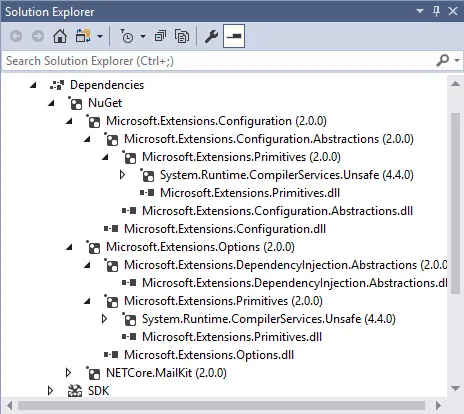我希望使用强类型的类来访问appsettings.json文件(以及其他配置文件)。在.NET Core 1中有很多关于如何做到这一点的信息(例如:https://weblog.west-wind.com/posts/2016/may/23/strongly-typed-configuration-settings-in-aspnet-core),但是关于.NET Core 2的几乎没有。
此外,我正在构建一个控制台应用程序,而不是ASP.NET。
看起来,在.NET Core 2中,配置API已经完全改变了。我无法理解它。有人可以帮忙吗?
编辑:我认为Core 2文档还没有跟上。例如:https://learn.microsoft.com/en-us/dotnet/api/microsoft.extensions.configuration.configurationbinder?view=aspnetcore-2.0显示,您会认为ConfigurationBinder存在于.NET Core 2中,但是在Microsoft.Extensions.Configuration和Microsoft.Extensions.Options的对象浏览器搜索中找不到任何内容。
我已经使用NuGet控制台进行了以下操作:
此外,我正在构建一个控制台应用程序,而不是ASP.NET。
看起来,在.NET Core 2中,配置API已经完全改变了。我无法理解它。有人可以帮忙吗?
编辑:我认为Core 2文档还没有跟上。例如:https://learn.microsoft.com/en-us/dotnet/api/microsoft.extensions.configuration.configurationbinder?view=aspnetcore-2.0显示,您会认为ConfigurationBinder存在于.NET Core 2中,但是在Microsoft.Extensions.Configuration和Microsoft.Extensions.Options的对象浏览器搜索中找不到任何内容。
我已经使用NuGet控制台进行了以下操作:
- Install-Package Microsoft.Extensions.Options -Version 2.0.0
- Install-Package Microsoft.Extensions.Configuration -Version 2.0.0

ConfigurationBinder在Microsoft.Extensions.Configuration.BinderNuGet 包中。 - Martin Ullrich